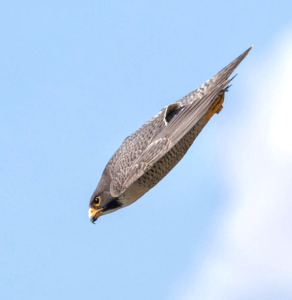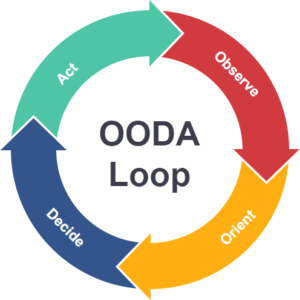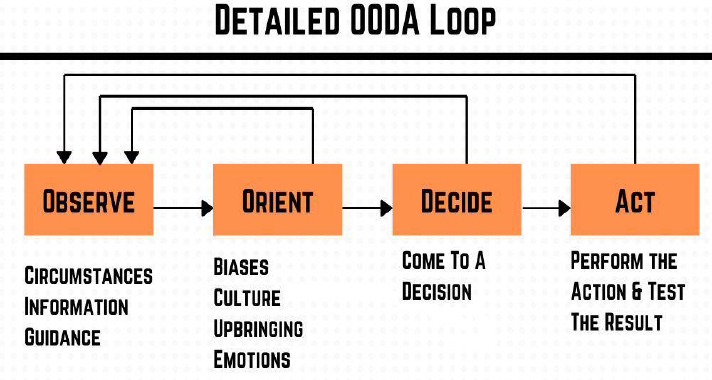Lessons from the Falcon (OODA)
Aug 3, 2021 // By:admin // No Comment
 Most people visualize a Peregrine Falcon as a small bird of prey flying like hawks and eagles … soaring in circles, looking for ground prey to pick up (or carrion to snack on). Few truly appreciate the fact that this is a bird of prey only 18″ long that attacks it’s in-air prey in power dives (called “stooping”) averaging airspeed of 180-240 miles per hour !
Most people visualize a Peregrine Falcon as a small bird of prey flying like hawks and eagles … soaring in circles, looking for ground prey to pick up (or carrion to snack on). Few truly appreciate the fact that this is a bird of prey only 18″ long that attacks it’s in-air prey in power dives (called “stooping”) averaging airspeed of 180-240 miles per hour !
 It achieves this aerodynamic feat, by starting from a tactically advantageous position from above, and folding it’s wings along its body to form a streamlined torpedo for attack, it slams into it’s prey from above at full speed, killing it upon impact.
It achieves this aerodynamic feat, by starting from a tactically advantageous position from above, and folding it’s wings along its body to form a streamlined torpedo for attack, it slams into it’s prey from above at full speed, killing it upon impact.
It’s eyes watch its prey for every movement. Its wings adjust accordingly in the high speed to correct its trajectory for impact.
Lets summarize what this falcon does and outline the process in steps:
- It watches for the right opportunity (Observe)
- It maintains an advantageous perspective, adjusting accordingly to maintain probability of success (Orientation)
- It decides which prey to attack and commits to the choice (Decision)
- It dives with speed (unless the situation drastically changes which causes the falcon to call off the attack) (Action)
Observe
Orient
Decide
Act

This is the OODA loop (as taught and popularized by pilot James Boyd)

In the above context, the OODA loop is a responsive system. the observer is collecting data as it happens, orienting to the context as it happens, and then deciding upon a responsive action.
As you can see, each phase can loop back to the first phase of observe (as it should), but being stuck in observation too long means “frozen” and is dangerous.
The more familiar the observer is with the items under the observe phase the faster they tend to move through orient and into decide and act. (this reduces the response time required and improves reaction time to the observed data)
Let’s start breaking this down into useful sections:
- You can’t observe properly if you are unaware of your current situation and any potential threats in it.
- Be aware of transitions (moving from one environment to another)
- Situational awareness and knowledge of pre-warning signs
- Be willing to change your orientation to observe better.
- Be willing to decide and act in order to orient better in order to observe better.
- (which helps ensure a better decision based upon more accurate or complete observed data)
- Levels of threat assesssment: (and your attached mental and physical readiness)
- White (no threat)
- your skipping through a field of flowers with no bees !
- Yellow (potential threat)
- suspicion is raised, human behavior, odd clothing use or flag raised from profiling skills
- environmental transitions should always put you on yellow (i.e moving from one “white” area to another)
- visual incongruity with expected safe environment
- something is there that doesn’t belong
- something is missing that should be there
- it is in this stage that you should also be looking for additional similar threats (predators often work in pairs/teams)
- Orange (confirmed threat – not engaged)
- escape route identified but not accomplished
- threat is not yet directly engaged, but seems imminent
- Red (engaged threat)
- White (no threat)
think of this as see, analysis then decision for response. You are always responding to something (that something has the initiative, which puts you in the defensive mode)
you have two options:
- either respond really fast
- recapture initiative (and put the attacker on defense)
The OODA loop can also be used in an active manner against an attacker by keeping them in their observe – orient loop (and keeping them from decision – action). Unpredictability is your advantage in this regard.
The attacker has likely been in the role of predator, observing you, already oriented to the surroundings and your movements, decided when to attack and how based upon predicted and probably movement and responses. They have the advantage of the initiative (and force you to respond to their attack) Don’t be predictable, change-up movement, direction of attention, force them into the beginning o the OODA loop and regain the initiative.
Exposure to varieties of situations helps us in the observe/orient phases
Training helps us in the Decide/Act phases
Both exposure and training are needed to successfully pass from observe to act.





